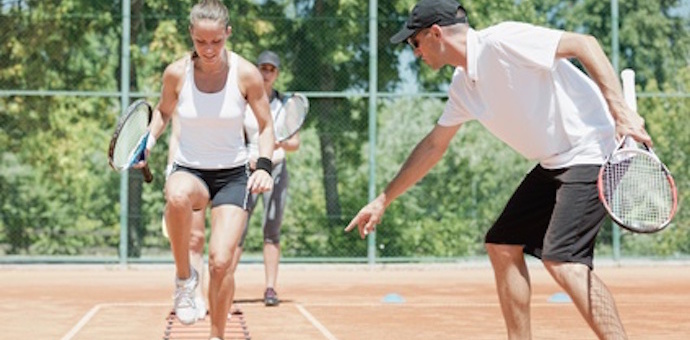A tennis training program has to meet the demands of an all-round physically challenging, individual sport.
For a tennis player to perform at their best, they must have just the right mix of aerobic and anaerobic endurance, explosive strength and power, speed off the mark and agility. In fact, the amount of strength, speed, agility and flexibility conditioning a player is prepared to undertake has been linked to the standard they play at (1).
A tennis match is characterized by repeated bouts of high-intensity activity. However, a typical rally may last about 6 seconds (2) and not much more than 10 seconds even on a clay court. Between points there is the luxury of up to 25 seconds rest – 90 seconds if it’s a changeover. Hence, the overall physical demand is closer to prolonged moderate-intensity exercise (such as distance running) than a true multisprint sport (such as soccer) (3).
A tennis training program must be based on solid aerobic endurance to sustain a high work rate for the duration of a game that may last several hours. Anaerobic endurance is also an essential component so that power over each rally, and in each shot within a rally can be maintained to same high level.
On average a tennis player will move just 3 meters per shot and 8-12 meters during a point (5). It becomes obvious that good speed and quickness around the court is essential in order to reach the majority of these shots. During a match 48% of a players movement is sideways (6) so agility, or the ability to change direction rapidly and under control becomes equally as important.
Finally, a balanced tennis training program should help to prevent injury and over training. For example, a preventative program of wrist extensor strengthening and stretching exercises can help to prevent tennis elbow (7). Specific exercises can also be prescribed to reduce the risk of rotator cuff damage.
Take a look through the articles below as we uncover some of the key principles involved in the complete tennis training approach.
Tennis Training Programs & Articles
The Sport-Specific Approach to Strength Training ProgramsStrength training for sport is very different than simply lifting weights. The only goal of tennis strength program is to improve performance not to lift heavier and heavier weights…
How To Design Resistance Training Programs For sportThis complete guide covers the various design elements of a successful, sport-specific strength training regimen…
The Elite Approach to Tennis Strength TrainingStrength conditioning is essential for all levels of tennis players. Here’s exactly how should put together a tennis-specific strength taining program…
A Complete Tennis Weight Training RoutineHere’s some tennis-specific weight training routines with sets and reps. Be sure to read the article above first though…
Power Training For SportMany athletes require explosive power to be successful in their sport. Once maximal strength strength has been developed there are several methods to convert it into sport-specific power…
Plyometric Training for Sport-Specific PowerThis article outlines the basics – sets, repetitions, rest intervals, exercise selection saftey considerations – for putting together an effective plyometric training session. It includes a sample session for tennis…
Muscular Endurance TrainingTennis requires both power and strength endurance. This article covers how to develop the latter…
Interval Training for Sport-Specific EnduranceInterval training is more demanding than continuous type training and brings about different adaptations. It is also more suitable for multi-sprint sports such as tennis…
Agility & Quickness ExercisesAgility training helps tennis players to move around the court quickly and reach more shots…
Ladder Agility Drills for Quick Feet & CoordinationSpeed ladders are a simple yet effective tool for developing agility. Use these drills within your tennis training program to improve your foot speed and coordination…
Flexibility ExercisesGood flexibility is important in most sports, not least tennis. Use theses stretching exercises after a game or tennis training session to increase your range of motion…
Forearm & Rotator Cuff ExercisesHelp to prevent overuse injuries such as tennis elbow with these simple exercises…
Tennis Training in the Off/Closed SeasonLike all athletes, tennis players need structured breaks from their training. But while the closed-season is about rest and regeneration, that doesn’t mean doing nothing at all…
How to Choose a Tennis Racket, According to Science – 11 Factors to Consider
Are you using the right tennis racket? There’s more to buying a tennis racket than grip. After spending a lot[…]
References
1) E. Paul Roetert, Scott W. Brown, Patricia A. Piorkowskil and Ronald B. Woods. Fitness Comparisons Among Three Different Levels of Elite Tennis Players. Journal of Strength and Conditioning Research. 1996 Vol. 10, No. 3, pp. 139143
2) Smekal G, von Duvillard SP, Rihacek C, Pokan R, Hofmann P, Baron R, Tschan H, Bachl N. A physiological profile of tennis match play. Med Sci Sports Exerc. 2001 Jun;33(6):999-1005
3) Bergeron MF, Maresh CM, Kraemer WJ, Abraham A, Conroy B, Gabaree C. Tennis: a physiological profile during match play. Int J Sports Med. 1991 Oct;12(5):474-9
4) Parsons LS and Jones MT. Development of Speed, Agility, and Quickness for Tennis Athletes. Strength and Conditioning. 1998 5) Gambetta V. Building the complete athlete 3rd ed. Sarasota FL: Gambetta Sports Training Systems, 1996.
Vol. 20, No. 3, pp. 1419

Jacky has a degree in Sports Science and is a Certified Sports and Conditioning Coach. He has also worked with clients around the world as a personal trainer.
He has been fortunate enough to work with a wide range of people from very different ends of the fitness spectrum. Through promoting positive health changes with diet and exercise, he has helped patients recover from aging-related and other otherwise debilitating diseases.
He spends most of his time these days writing fitness-related content of some form or another. He still likes to work with people on a one-to-one basis – he just doesn’t get up at 5am to see clients anymore.
